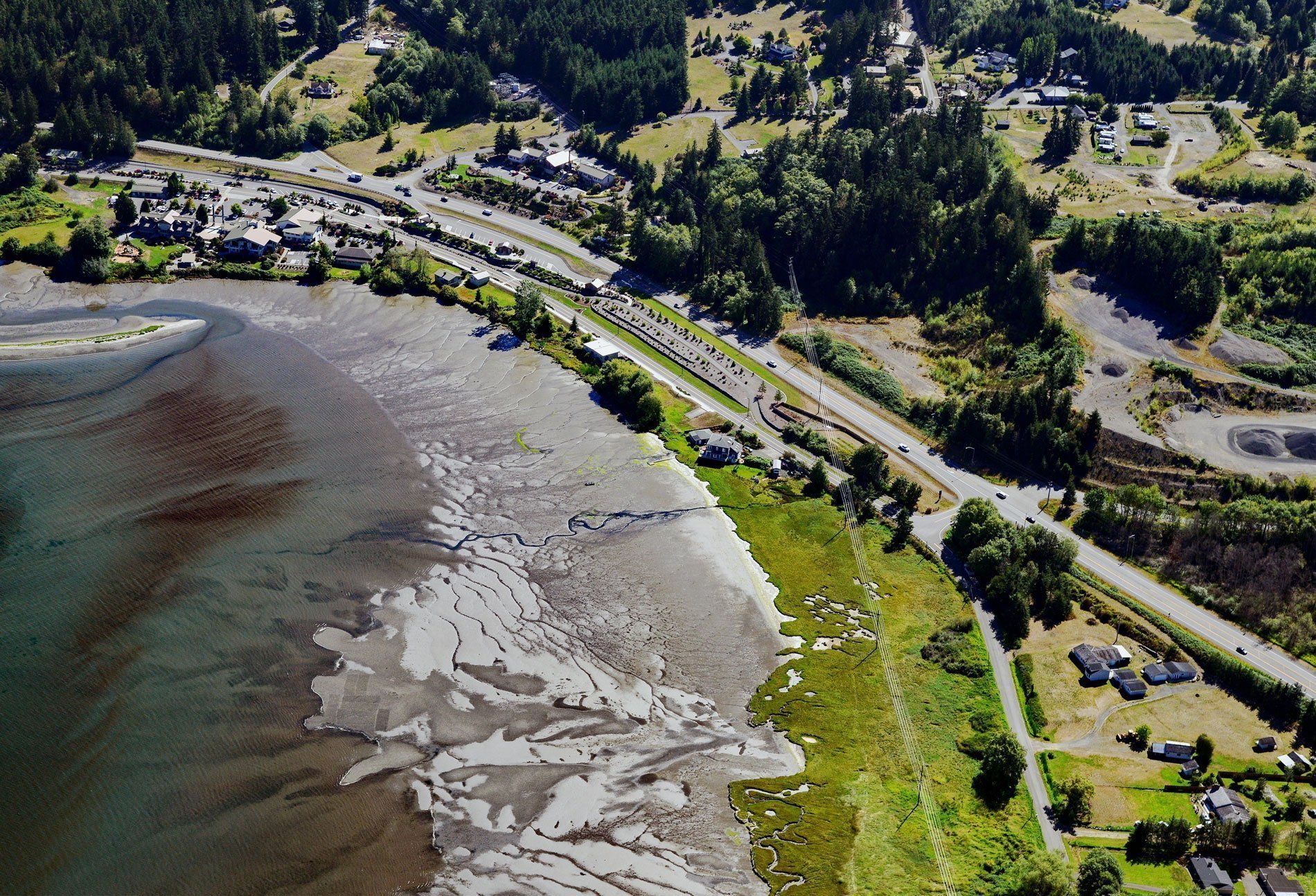Blyn is a small community located where Jimmycomelately Creek flows into Sequim Bay on the northern coast of the Olympic Peninsula, about 13 miles (21 km) southwest of Port Townsend and 7 miles (11 km) southeast of Sequim, Washington. Blyn was founded in 1891 by Benjamin F. Dean who bought the Whitcomb homestead of 160 acres (65 ha) at the head of Sequim Bay and opened a store and post office on the property. The name reputedly originates from a man known as Romo who could not pronounce the name of Dean’s son Orville, and called him ‘Oblyn’, which was shortened to ‘Blyn’, and the nickname was bestowed on the new town. Other documents suggest that the town was named after a mill operator named Marshall Blinn, who founded Seabeck on Hood Canal, or the town may have been named for Captain Blyn, a pioneer who lived at the head of the bay but little is known about him. Sequim Bay was once called Washington Harbor. The name ‘Sequim’ comes from a S’Klallam language word once thought to mean ‘quiet water’, referring to the calm bay protected from waves in the Strait of Juan de Fuca by two large overlapping sandbars. However, recent linguistic studies suggest the word means ‘a place for going to shoot’, referring to the once abundant wildlife in the area. Jimmycomelately Creek may have been named after a watchmaker named Jimmy Whittier who was an early settler, or it may have been a term referring to newcomers who were ill-prepared for pioneer living on the Olympic Peninsula. Jimmycomelately Creek has a watershed of 35,813 acres (14,500 ha) and flows generally north from the north flank of Mount Zion to Sequim Bay with a vertical drop of 2,500 feet (760 m) over 19.8 miles (32 km). The watershed is mostly on federal and state forestland with 8,935 acres (3,616 ha) containing timber at least 60 years of age or older. The relatively steep, forested portion of the drainage ends approximately 1.8 miles (2.9 km) from saltwater, at which point the river enters a more gently sloping area that was historically old-growth forested wetlands. The creek watershed is mostly underlain by basalt flows from the early to middle Eocene, or 56 to 34 million years ago. The head of Sequim Bay is underlain by alluvial sediments composed of sand, silt, and gravel. This material is mostly from ground moraines deposited by glaciers during the Pleistocene.
The S’Klallam people inhabited this area for millennia and possess a rich social and religious culture based on the abundant food and building materials available in the region. The name is derived from ‘nuxsklai’yem’ in the Coast Salish language meaning ‘strong people’. The S’Klallam occupied a territory that extended along the Strait of Juan de Fuca from the Hoko River to the west and beyond Discovery Bay to the east, with as many as 30 villages at river mouths or sheltered harbors. The populous and powerful S’Klallam had seasonal camps as far away as Vancouver Island, the San Juan Islands, and Whidbey Island. Contact with Europeans began in the 1700s and increased in the 1800s, after the establishment of Hudson’s Bay Company trading posts. The S’Klallam traded at Fort Langley, Fort Nisqually, and Fort Victoria, which were established in the 1820s, 1830s, and 1840s, respectively. The S’Klallam entered into the Point No Point Treaty with the United States in 1855 but remained in their traditional areas. In 1874, the S’Klallams from the village at Dungeness declined government recognition and privately purchased 210 acres (85 ha) of land and established Jamestown, named after James Balch who was a prominent chief, and supported themselves by gardening, farming, fishing, and working in lumber mills. Beginning in the 1950s, the three S’Klallam Tribes combined to litigate land claims and fishing rights granted in the Point No Point Treaty. The Jamestown S’Klallam tribe received federal recognition on February 10, 1981, receiving trust land of 13.49 acres (5.5 ha) at Blyn on Sequim Bay which is now the location of the tribal government administration in the Jamestown S’Klallam Tribal Center. They also built the Seven Cedars Casino and the Longhouse Market. In addition, the tribe also owns more than 1,000 acres (405 ha) of nearby land.
Jimmycomelately Creek and Sequim Bay have long been important to the
Jamestown S’Klallam people as a traditional hunting, fishing, shellfishing, and gathering area. Historically every creek entering the bay had at least one fish trap used to catch chum salmon. Development of Sequim Bay began in the late 1800s with logging, road and railroad construction, dredging, and wetland diking, drainage, and filling. Jimmycomelately Creek was relocated, channelized and straightened, and constricted by roads and fill to facilitate farming and the settlement of Blyn. Wetlands were drained and filled for a sawmill and a log yard that was in operation until the late 1990s. From 1974 to 2002, the estimated mean catch was 49 summer chum, but from 1993 to 2002 it was effectively zero. In 1999, only seven chum salmon returned to the creek to spawn and the run was listed as threatened with extinction. The summer chum is one the earliest Pacific salmon to spawn, and they generally reproduce in the lowest reaches of streams. The Jamestown S’Klallam tribe, the Clallam Conservation District, Clallam County, and others began to address the problems associated with declining fish populations and developed partnerships, sought funding, and implemented restoration plans. Jimmycomelately Creek was realigned to its historic meandering configuration, the link between the creek and the tidal wetlands was re-established, and the estuarine habitat was restored. Other remediation projects included the removal of fill and logging roads, the construction of a new highway bridge, restoring native vegetation, and land acquisition required to accomplish the restoration goals. Read more here and here. Explore more of Blyn and Sequim Bay here:

